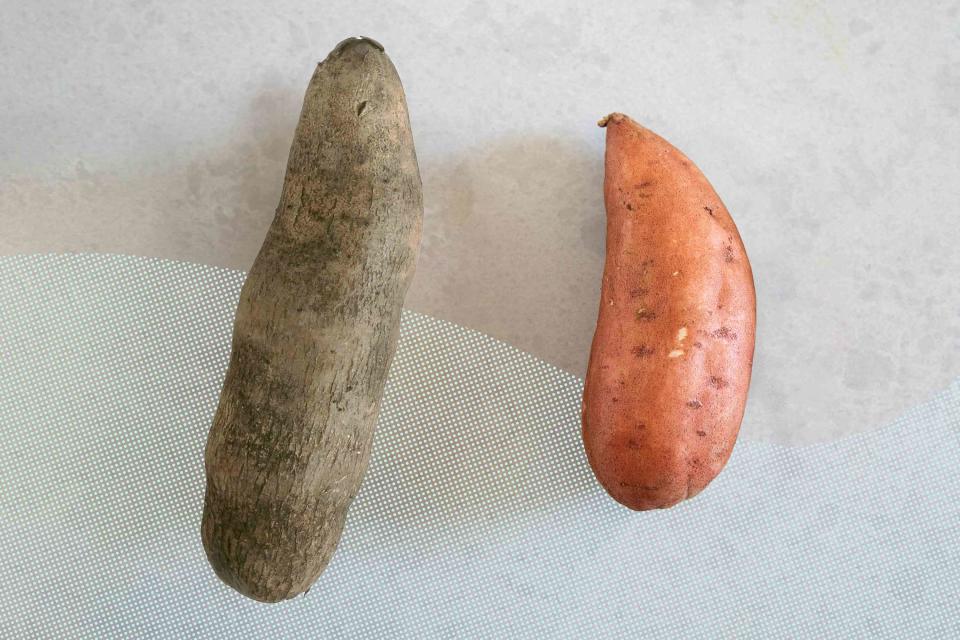Sweet Potato vs. Yam: Experts Explain the Difference
Know your root veg.

Simply Recipes / Photos by Lori Rice and Getty Images
“What’s in a name?” William Shakespeare once wrote. “Would a rose by any other name smell as sweet?” It’s a valid point for sure… unless we’re talking about sweet potatoes. Because one by its other name—a yam—is certainly not.
If we’re being technically correct, we’re no longer talking about the same tuber anymore. Those bright orange cuts in syrup in cans labeled “yams” in huge letters aren’t even related to real yams! Chances are, most of us have never even had actual yams—just different types of sweet potatoes.
So, what are yams and what are sweet potatoes? Let’s get to the “root” of the matter.
Why Are Sweet Potatoes Also Called Yams in the United States?
Before the 1930s, sweet potatoes in the United States were called exactly what they are: sweet potatoes. It wasn’t until researcher Julian C. Miller of the Louisiana Experiment Station developed the bright orange-fleshed sweet potatoes that have become the predominant species that they began to be known as yams.
Seeking to distinguish this new, creamy, less stringy and more tender-skinned cultivar from the less sweet, firmer, and pale yellow original sweet potatoes, this delicious newcomer was marketed as “yams” to establish them as their own special type.
However, this verbiage has deeper roots than century-old marketing, with direct ties to slavery. Yams are a crucial staple food in Africa – one so important to West African diets that the name was derived from the word “to eat” in various languages of that region. In fact, the Igbo people so revere this important vegetable that it’s been called “king of crops” and the New Yam Festival is celebrated every year to honor the harvest.
Knowing what a critical and affordable food source this was but unable to acquire them in the New World, slave traders fed their captives Caribbean and Central American sweet potatoes in lieu, and thus enslaved Africans began calling these soft white sweet potatoes yams for lack of a better term.
Today, the U.S. Department of Agriculture requires anything other than a true yam also bear labeling that says “sweet potato” somewhere. But technically, it is still permissible to use the word “yam” in tandem—hence those canned “yams” that have become ubiquitous for sweet potato pie season!

Simply Recipes / Lori Rice
The Difference Between Yams and Sweet Potatoes
Both come from angiosperms, or flowering plants, but are stem tubers grown underground that tend to be cylindrical in shape. The fruit of each can be used as slips to sprout new sweet potato and yam plants, making them prolific and fruitful harvest crops.
This is part of why they’re so important to the cultures in which they are consumed, particularly thanks to their filling, nutritional profiles and starchy staple food status as well as their long-storing qualities. For these reasons, both yams and sweet potatoes have been cultivated to a variety of species and colors, all with their own individual taste and textural nuances.
Nutritionally, they have similar traits as well. Neither have enough fat to warrant mention.
Sweet Potatoes
Sweet potatoes are native to Central or South America and have been grown as crops for over five thousand years. They can come in a rich rainbow of colors and are often divided into two classifications: hard and soft. This is a reference to how they cook up. The hard ones remain firmer with a crumbly texture and some waxiness; the soft ones are most common, breaking down creamy, smooth, fluffy, and fabulously sweet.
North Carolina is the top producer of the orange sweet potatoes that are predominant in our markets.
Read More: The Only Way To Prevent Sweet Potatoes From Shriveling Up and Rotting

Simply Recipes / Photo by Getty Images
Yams
Yams, on the other hand, are native to Africa, Asia, and Oceana, and although 870 species of yams exist, Africa remains the primary grower, supplying 95% of the world’s true yams. In Malaysia and Singapore, what is referred to as a yam is actually taro. In New Zealand, their yams are really oca, which isn’t related to either yams or sweet potatoes.
Yams are dark brown, hairy-skinned in a scaly way, long, and can be enormous—up to six feet in length. Their tremendous size capability can make them challenging to harvest, but not impossible. Most cultivated types from West Africa have pale white flesh, but they can also have off-white or yellow interiors. The ones with purple or red interiors are typically Asian varietals from Japan, Indonesia, Vietnam, and the Philippines.
Yams have to be sought out at specialty or international markets. Asian, Caribbean, and African stores may carry them in their produce sections, where they are typically cut into chunks or slices then wrapped in plastic. In some cases, you may find whole yams but double check to make sure you’re not buying yucca!
You can also find yams dehydrated and labeled as huai shan in Asian and Chinese markets.
The biggest and most important difference is how they taste. Overall, yams skew on the neutral side. They’re very starchy and reminiscent of white potatoes, with a mild sweetness that easily gives way to take on the flavor of their seasoning, while sweet potatoes have varying levels of sweetness based on their types.
Read the original article on Simply Recipes.


